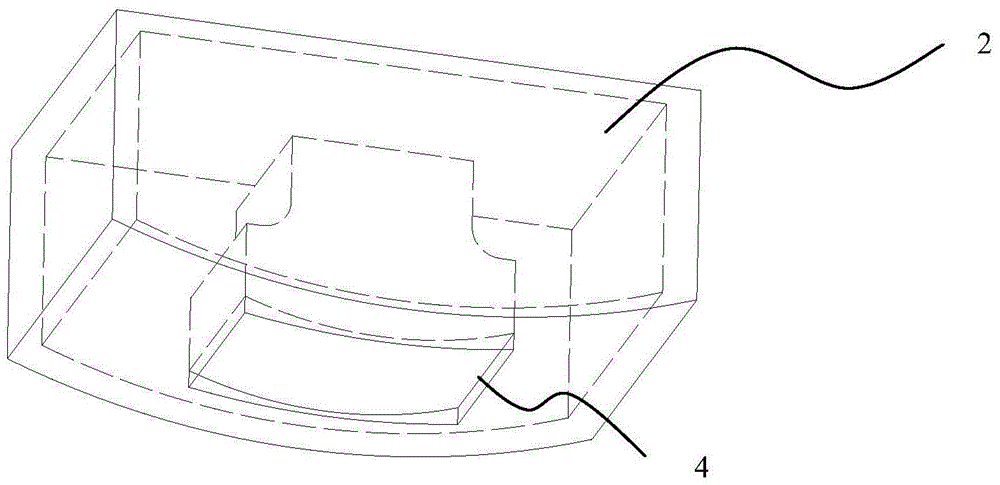Finger Cot Ultrasound Probe
An ultrasonic probe and finger cot technology, applied in the field of medical devices, can solve problems such as puncture errors, cumbersome operation, and failure to effectively reflect the role of the ultrasonic probe, and achieve the effects of convenient use, large detection area, and improved puncture success rate
- Summary
- Abstract
- Description
- Claims
- Application Information
AI Technical Summary
Problems solved by technology
Method used
Image
Examples
Embodiment 1
[0030] A finger-sleeve type ultrasonic probe comprises a casing, a transducer 4 and other matching parts related to the transducer. The casing is composed of a finger-sleeve 1 and a casing 2 . The finger cover is a cylinder with a through hole in it. The finger cover 1 has a double-layer structure. The outer layer is made of a material with a certain hardness, and the inner layer material is relatively soft. The case 2 is located on the outer side of the outer circle of the finger cover 1. When the finger is inserted into the finger cover 1, the case will be at the pulp of the finger. The inside of the case 2 has a cavity, the top is not closed, and there is a hole at the bottom. The side wall of the casing 2 and the finger cover are connected by bolts. The transducer 4 and related accessories are installed inside the casing 2, wherein the acoustic window 41 of the transducer 4 corresponds to the hole 21 on the casing 2, and the acoustic window 41 can pass through the hole 21 ...
Embodiment 2
[0032] like Figure 1 to Figure 3 As shown, a finger-sleeve type ultrasonic probe, the rest is the same as that of Embodiment 1, the casing further includes a connecting device 3, and the top of the casing 2 is closed. The connecting device 3 is a slider 31 and a slider seat 32 , the slider 31 is installed in the slider seat 32 , and the slider seat 32 is fixed on the top of the casing 2 . There are two slideways 11 on both sides in the circumferential direction of the finger cover, which are mirror-distributed relative to the casing 2. After the slider 31 on the connecting device 3 is clamped with the slideway 11, the connecting device 3 and the casing 2 can be made around the finger cover. Circumferential movement. The angle formed between the two ends of the slideway 11 and the axial direction of the finger cover is 15°, so the angle of the circumferential movement of the casing 2 around the finger cover 1 is 15°, which meets the needs of general detection.
Embodiment 3
[0034] like Figure 4 , Figure 5 A finger-sleeve ultrasonic probe is shown, the rest is the same as that of Embodiment 1, and the object includes a connecting device 3 . The connecting device 3 is a universal joint, and the two universal joint forks of the universal joint are respectively connected with the finger sleeve 1 and the casing 2 , wherein the connection with the casing 2 is completed by means of the connecting shaft 33 . Through the connection of the universal joint, the ultrasonic probe can complete the circumferential movement around the finger cuff and the forward and backward movement. Both ends of the finger cover 1 are smooth curved surfaces, and the intersection of the side surface of the casing 2 and the finger cover 1 is also relatively smooth, so that the freedom of the ultrasonic probe in two directions is not hindered. There are two stoppers 12 on both sides in the circumferential direction on the upper part of the finger cover 1 , which are mirrored ...
PUM
 Login to View More
Login to View More Abstract
Description
Claims
Application Information
 Login to View More
Login to View More - R&D
- Intellectual Property
- Life Sciences
- Materials
- Tech Scout
- Unparalleled Data Quality
- Higher Quality Content
- 60% Fewer Hallucinations
Browse by: Latest US Patents, China's latest patents, Technical Efficacy Thesaurus, Application Domain, Technology Topic, Popular Technical Reports.
© 2025 PatSnap. All rights reserved.Legal|Privacy policy|Modern Slavery Act Transparency Statement|Sitemap|About US| Contact US: help@patsnap.com



